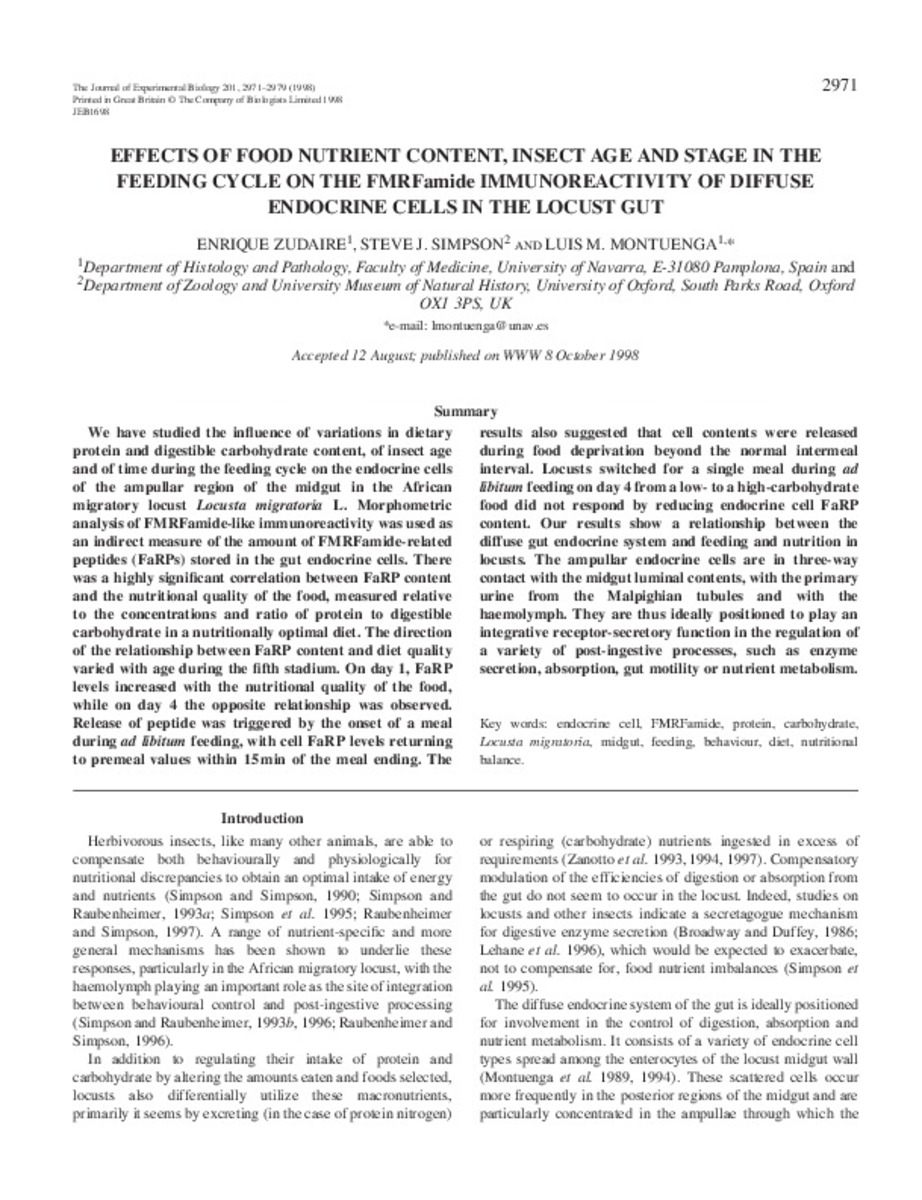Full metadata record
| DC Field | Value | Language |
|---|---|---|
| dc.creator | Zudaire, E. (Enrique) | - |
| dc.creator | Simpson, S.J. (Steve J.) | - |
| dc.creator | Montuenga-Badia, L.M. (Luis M.) | - |
| dc.date.accessioned | 2011-12-09T18:54:38Z | - |
| dc.date.available | 2011-12-09T18:54:38Z | - |
| dc.date.issued | 1998 | - |
| dc.identifier.citation | Zudaire E, Simpson SJ, Montuenga LM. Effects of food nutrient content, insect age and stage in the feeding cycle on the FMRFamide immunoreactivity of diffuse endocrine cells in the locust gut. J Exp Biol 1998 Nov;201(Pt 21):2971-2979. | es_ES |
| dc.identifier.issn | 1477-9145 | - |
| dc.identifier.uri | https://hdl.handle.net/10171/20165 | - |
| dc.description.abstract | We have studied the influence of variations in dietary protein and digestible carbohydrate content, of insect age and of time during the feeding cycle on the endocrine cells of the ampullar region of the midgut in the African migratory locust Locusta migratoria L. Morphometric analysis of FMRFamide-like immunoreactivity was used as an indirect measure of the amount of FMRFamide-related peptides (FaRPs) stored in the gut endocrine cells. There was a highly significant correlation between FaRP content and the nutritional quality of the food, measured relative to the concentrations and ratio of protein to digestible carbohydrate in a nutritionally optimal diet. The direction of the relationship between FaRP content and diet quality varied with age during the fifth stadium. On day 1, FaRP levels increased with the nutritional quality of the food, while on day 4 the opposite relationship was observed. Release of peptide was triggered by the onset of a meal during ad libitum feeding, with cell FaRP levels returning to premeal values within 15 min of the meal ending. The results also suggested that cell contents were released during food deprivation beyond the normal intermeal interval. Locusts switched for a single meal during ad libitum feeding on day 4 from a low- to a high-carbohydrate food did not respond by reducing endocrine cell FaRP content. Our results show a relationship between the diffuse gut endocrine system and feeding and nutrition in locusts. The ampullar endocrine cells are in three-way contact with the midgut luminal contents, with the primary urine from the Malpighian tubules and with the haemolymph. They are thus ideally positioned to play an integrative receptor-secretory function in the regulation of a variety of post-ingestive processes, such as enzyme secretion, absorption, gut motility or nutrient metabolism. | es_ES |
| dc.language.iso | eng | es_ES |
| dc.publisher | Company of Biologists | es_ES |
| dc.rights | info:eu-repo/semantics/openAccess | es_ES |
| dc.subject | Endocrine cell | es_ES |
| dc.subject | FMRFamide | es_ES |
| dc.subject | Protein | es_ES |
| dc.subject | Carbohydrate | es_ES |
| dc.subject | Locusta migratoria | es_ES |
| dc.subject | Midgut | es_ES |
| dc.subject | Feeding | es_ES |
| dc.subject | Behaviour | es_ES |
| dc.subject | Diet | es_ES |
| dc.subject | Nutritional balance | es_ES |
| dc.title | Effects of food nutrient content, insect age and stage in the feeding cycle on the FMRFamide immunoreactivity of diffuse endocrine cells in the locust gut | es_ES |
| dc.type | info:eu-repo/semantics/article | es_ES |
| dc.relation.publisherversion | http://jeb.biologists.org/content/201/21/2971 | es_ES |
Files in This Item:
Statistics and impact
Items in Dadun are protected by copyright, with all rights reserved, unless otherwise indicated.






